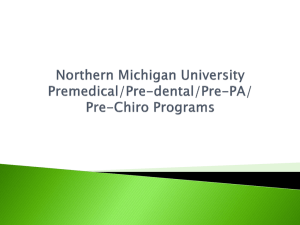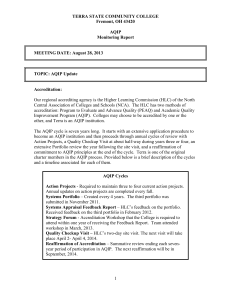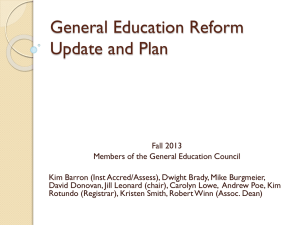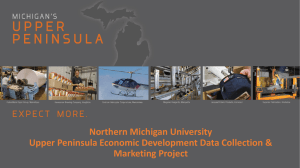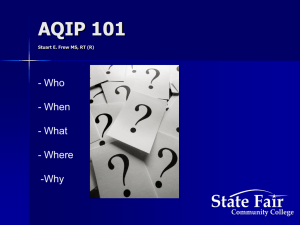Facilities Plan 12-13Revised - Share @ NMU
advertisement
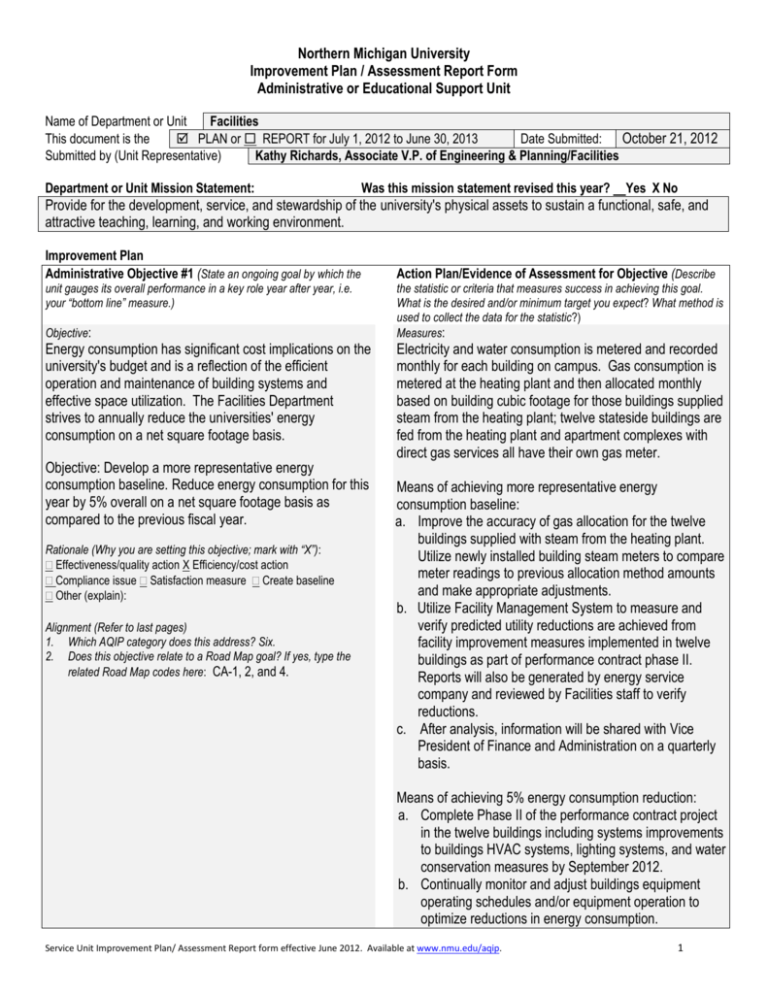
Northern Michigan University Improvement Plan / Assessment Report Form Administrative or Educational Support Unit Name of Department or Unit Facilities This document is the PLAN or REPORT for July 1, 2012 to June 30, 2013 Date Submitted: October 21, 2012 Submitted by (Unit Representative) Kathy Richards, Associate V.P. of Engineering & Planning/Facilities Department or Unit Mission Statement: Was this mission statement revised this year? Yes X No Provide for the development, service, and stewardship of the university's physical assets to sustain a functional, safe, and attractive teaching, learning, and working environment. Improvement Plan Administrative Objective #1 (State an ongoing goal by which the unit gauges its overall performance in a key role year after year, i.e. your “bottom line” measure.) Objective: Energy consumption has significant cost implications on the university's budget and is a reflection of the efficient operation and maintenance of building systems and effective space utilization. The Facilities Department strives to annually reduce the universities' energy consumption on a net square footage basis. Objective: Develop a more representative energy consumption baseline. Reduce energy consumption for this year by 5% overall on a net square footage basis as compared to the previous fiscal year. Rationale (Why you are setting this objective; mark with “X”): Effectiveness/quality action X Efficiency/cost action Compliance issue Satisfaction measure Create baseline Other (explain): Alignment (Refer to last pages) 1. Which AQIP category does this address? Six. 2. Does this objective relate to a Road Map goal? If yes, type the related Road Map codes here: CA-1, 2, and 4. Action Plan/Evidence of Assessment for Objective (Describe the statistic or criteria that measures success in achieving this goal. What is the desired and/or minimum target you expect? What method is used to collect the data for the statistic?) Measures: Electricity and water consumption is metered and recorded monthly for each building on campus. Gas consumption is metered at the heating plant and then allocated monthly based on building cubic footage for those buildings supplied steam from the heating plant; twelve stateside buildings are fed from the heating plant and apartment complexes with direct gas services all have their own gas meter. Means of achieving more representative energy consumption baseline: a. Improve the accuracy of gas allocation for the twelve buildings supplied with steam from the heating plant. Utilize newly installed building steam meters to compare meter readings to previous allocation method amounts and make appropriate adjustments. b. Utilize Facility Management System to measure and verify predicted utility reductions are achieved from facility improvement measures implemented in twelve buildings as part of performance contract phase II. Reports will also be generated by energy service company and reviewed by Facilities staff to verify reductions. c. After analysis, information will be shared with Vice President of Finance and Administration on a quarterly basis. Means of achieving 5% energy consumption reduction: a. Complete Phase II of the performance contract project in the twelve buildings including systems improvements to buildings HVAC systems, lighting systems, and water conservation measures by September 2012. b. Continually monitor and adjust buildings equipment operating schedules and/or equipment operation to optimize reductions in energy consumption. Service Unit Improvement Plan/ Assessment Report form effective June 2012. Available at www.nmu.edu/aqip. 1 Assessment Report Summary of Data Collected (Provide trend data and summary) Description of how results were used to improve services (Fill this cell only for the REPORT at the end of the year.) (Fill this cell only for the REPORT at the end of the year.) Improvement Plan Administrative Objective #2 (State a 1-2 year objective intended to improve a unit process, service, or output.) Objective: Improve learning environment on campus through the consolidation of academic departments to the core of campus, creation of flexible, high-tech classrooms, reassignment of underutilized instructional space, and enhancement of informal learning spaces. Rationale (Why you are setting this objective; mark with “X”): X Effectiveness/quality action Efficiency/cost action Compliance issue Satisfaction measure Create baseline Other (explain): Alignment (Refer to last pages) 1. Which AQIP category does this address? Six. 2. Does this objective relate to a Road Map goal? If yes, type the related Road Map codes here: CA-1 (Offers conclusions or interpretation and explains how data was used to make changes for improvement as related to the objective) Action Plan/Evidence of Assessment for Objective Describe timetable plans to achieve objective. Completion of Jamrich Hall Replacement project: a. Complete design of both traditional and active learning classrooms by October, 2012. b. Complete design in phases and prepare four bid packages: (1) Parking Lot by September, 2012; (2) Site/ Utilities/ Foundation/ Steel by January, 2013; (3) Enclosure/ Mechanical/Electrical April, 2013 (4) Interiors finishes June, 2013. c. Begin building construction in April, 2013. d. Regular progress meetings (typically monthly) will conducted with the Jamrich Hall Advisory Committee until construction commences. Once construction begins these meetings will be conducted as-needed. e. Review documents (drawings) are submitted to the State of Michigan at the completion of each design phase noted in item b and prior to soliciting bids from contractors. f. Monthly progress reports are submitted to the State of Michigan once construction begins. These reports are due on the 20th day of each month. Beyond completing the above steps, how will you judge whether the objective was a success? Examples: If the rationale was Efficiency/cost, what is the desired and/or minimum target criteria for savings in time or cost? If the rationale was Satisfaction, what is the measure and what increase is desired? For this stage of the project, the measure of success will be: a. Achieving consensus on the preferred classroom design for both traditional and active learning style classrooms and the amount and type of teaching technologies incorporated into each. b. Successfully meeting each of the four design/bid milestones noted for each bid packages. Assessment Report Summary of Data Collected #2 (Summarize the evidence) Description of how results were used to improve services (Fill this cell only for the REPORT at the end of the year.) (Fill this cell only for the REPORT at the end of the year.) Improvement Plan Service Unit Improvement Plan/ Assessment Report form effective June 2012. Available at www.nmu.edu/aqip. 2 Administrative Objective #3 (State a 1-2 year objective intended to improve a unit process, service, or output.) Objective: Reduce the utility costs associated with the operation of the heating plant by approximately $1.5 million per year. Rationale (Why you are setting this objective; mark with “X”): Effectiveness/quality action X Efficiency/cost action Compliance issue Satisfaction measure Create baseline Other (explain): Alignment (Refer to last pages) 1. Which AQIP category does this address? Six. 2. Does this objective relate to a Road Map goal? If yes, type the related Road Map codes here: CA-1, 2, and 4. Action Plan/Evidence of Assessment for Objective Describe timetable plans to achieve objective. Construction of the Ripley Heating Plant Combined Heat and Power Renewable Energy Project which includes a new 42,000 lb/hr solid fuel boiler with 735 kW steam turbine/generator as an addition to the existing Ripley Heating Plant. a. Install boiler and turbine by September, 2012. b. Perform first test burn by February, 2013. c. Complete construction by June, 2013. d. Progress reports will be given to Vice President of Finance and Administration on monthly basis. e. Emissions testing reports will be provided to the State of Michigan once boiler is in operation. Beyond completing the above steps, how will you judge whether the objective was a success? Once the project has been completed in June 2013, the overall operating costs for the heating plant will be reduced by balancing the generation of steam and fuel pricing to produce the most cost effective solution for heating, cooling, and electrical needs. The gas fired system will be used when gas prices are low and the wood fired system when wood prices are more competitive. Success will be measured by achieving targeted utility cost avoidance of $1.5 million per year. Assessment Report Summary of Data Collected #3 (Summarize the evidence) Description of how results were used to improve services (Fill this cell only for the REPORT at the end of the year.) (Fill this cell only for the REPORT at the end of the year.) AQIP Functions within the University: Some unit objectives address specific operational issues directly related to AQIP reporting. Listed below are AQIP categories. Use these category numbers to describe the context of each objective, i.e. which category does that objective address? (A full description of the Portfolio’s categories and its detailed topics are available at www.nmu.edu/aqip under the Current Document AQIP Categories Category 1 Helping Students Learn documents the curricular and co-curricular processes and student learning support. Category 2 Accomplishing Other Distinctive Objectives documents the key non-curricular functions by which NMU serves the region, e.g. community engagement initiatives of students and employees, and department outreach. Category 3 Understanding Students’ and Other Stakeholders’ Needs documents how NMU builds relationships with students, alumni and employers and identifies, targets and meets their needs. Category 4 Valuing People documents NMU personnel recruitment, training, satisfaction, services and programs. Category 5 Leading and Communicating documents processes that guide NMU in setting directions, making decisions, seeking future opportunities, and communicating decisions and actions. Category 6 Supporting Institutional Operations documents student and administrative support services, safety, and facilities. Category 7 Measuring Effectiveness documents IT systems and institutional research NMU employs to collect, analyze, and distribute, and how departments use them to manage improvement, e.g. use of charts, “cubes,” dashboards. Category 8 Planning Continuous Improvement documents NMU’s strategic and administrative planning processes. Category 9 Building Collaborative Relationships documents how NMU works with external organizations from which we receive students Service Unit Improvement Plan/ Assessment Report form effective June 2012. Available at www.nmu.edu/aqip. 3 (school systems) or goods and services (vendors and utilities), send our graduates (schools and employers), and support or regulate our programs (agencies). (A full description of the Portfolio’s categories and its detailed topics are available at www.nmu.edu/aqip under the Current Document Road Map Codes to Tie to Unit Objectives Some unit objectives are strategic initiatives that align with goals in the University strategic plan - Road Map to 2015. Listed below are Road Map categories and goals, preceded with a code. Use these codes when describing Objectives #2 and #3. (Note: Even if your objective is not an exactly itemized as a Road Map priority, still use the code if it applies to that goal.) The full Road Map is at www.nmu.edu/roadmap2015. Code I-1 I-2 I-3 I-4 ML-1 ML-2 ML-3 CA-1 CA-2 CA-3 CA-4 CE-1 CE-2 CE-3 CE-4 Road Map to 2015 Goals Innovation Goals Balance successful programs with new offerings Professional development program that rewards innovation and collaboration A growing portfolio of corporate collaborations that exploit NMU’s technical expertise, enhance academic programs and facilitate global engagement for students and faculty both on campus and abroad Develop the financial resources to support innovation and student success Meaningful Lives Goals A Liberal Studies Program that provides students with the abilities and knowledge necessary for lifelong learning and effective citizenship in a challenging and rapidly changing world Develop a new academic advising system that integrates the advising assets of academic departments and student services to contribute to a new, effective retention management network—similar to our enrollment management network Integrate the highest possible level of information technology skills and competencies throughout the university Campus Attributes Goals Utilize the Campus Master Plan and related initiatives to continue to build and develop a greener and more learner-centered campus Enhance processes throughout campus operations to guide the use of resources and inform resource allocation Enhance the portfolio of academic programs, research and other activities that leverage the university’s location Be a model community for sustainable education and practices Community Engagement Goals Include all units of the campus in the process of community engagement for the mutually beneficial exchange of knowledge and resources in a context of partnership and reciprocity. Increase faculty, staff and student involvement in the Superior Edge program, academic service learning and other community engagement and leadership development initiatives. Put into action a commitment to be an inclusive community where differences are recognized as assets of the institution, respected attributes of the person and a valuable part of the university experience Increase collaboration with local communities, schools, governments, development groups and other partners to enhance community and economic development in the Upper Peninsula. Service Unit Improvement Plan/ Assessment Report form effective June 2012. Available at www.nmu.edu/aqip. 4


